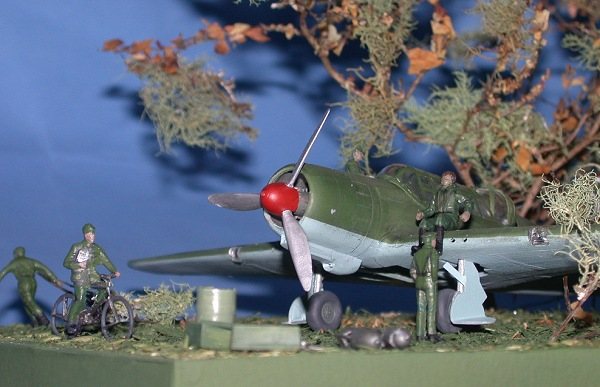
ICM 1/72 Su-2
|
KIT # |
72081 |
|
PRICE: |
$20.00 AUD |
|
DECALS: |
Two aircraft |
|
REVIEWER: |
|
|
NOTES: |

|
HISTORY |
For a short history and a look at what's in the box, have a look at the preview
|
THE KIT |
Since doing the preview of ICM's Su-2 I have been inundated with email from people having problems with the quality of their moldings and canopies, a few people remarked that their copy of the Su-2 was so five full of sink marks and divots that it was unbuildable, yet others like me had no problems with sink marks. From what I can ascertain early productions runs of this aircraft, say pre Dec 2001 seems to have the sink holes and short shot problems and later batches are fine. My recommendation would be to if at all possible have a look at the sprues before purchasing and in particular check the wings for sink marks and short shots.
 The biggest complaint I have
with ICM is their boxes, Mine didn’t even have the strength to hold together on
it's short trans Tasman trip, thankfully all the sprues are in a sealed plastic
bag otherwise I would have ended up with a flattened empty cardboard box!
The biggest complaint I have
with ICM is their boxes, Mine didn’t even have the strength to hold together on
it's short trans Tasman trip, thankfully all the sprues are in a sealed plastic
bag otherwise I would have ended up with a flattened empty cardboard box!
The superbly detailed wings of the ICM Su-2 are covered with thousands of scale rivets that look well "right" Airfix take note …you can make 1/72nd scale rivets! But as I'm a slash and bash type of modeller, 98% of that beautiful detail is going to end up getting wiped out.
The canopy is not the clearest and suffers from a few "stress" lines and a little clouding; a pre-emptive dip in future seems to make a big difference. The three piece turret isn’t too difficult to work with as I've been told by a few VVS modelers as long as you use slow setting glue and "tweak" it awhile you can get all the bits to line up.
Instructions are typical ICM, with easy to follow diagrams that are crisp and sharp with paint calls matched to the Humbrol range which is really handy if your local model shop only stocks Tamiya or Humbrol ranges.
I decided to do a diorama of the Su-2 depicted on the box top scene as a couple of the guys from the model club reckoned that it was one of the better "box-top stories" they had seen.
|
CONSTRUCTION |
Construction starts by finding all the bits that have fallen off the sprue and slid out of the box and onto the floor, once I had rounded up the cockpit tub/bomb bay and the two piece seat, added the control column and carefully slopped interior green all over everything it was time to trap the tub between the fuselage halves, the positioning of this is very vague and I found it was easier to glue the bottom bomb bay/tub to the hole in the one piece bottom wing with slow setting glue and temporally tape everything together until the glue dried, doing it this way means that the cockpit lines up with the bomb bay and allows the fuselage to close properly.
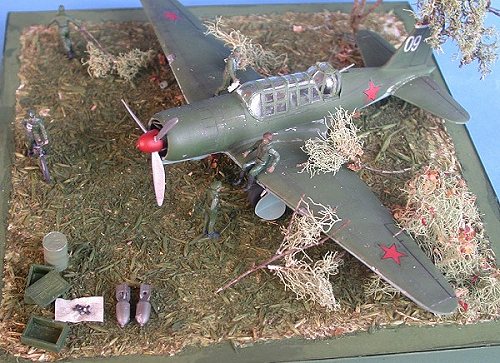 Once the cockpit was in
place the fuselage was closed up and the bottom wing removed again, a little
sanding on the underside was all that was needed to hide the join lines.
Once the cockpit was in
place the fuselage was closed up and the bottom wing removed again, a little
sanding on the underside was all that was needed to hide the join lines.
With the fuselage done all that was needed was the upper wing halves added to the lower one piece wing to finish off the major airframe components, here's were dry fittings showed up a small glitch, if done out of the box the Su-2 would end up with a negative dihedral on it's wings, this is a common problem I have found with three piece wings and is easy enough to fix by carefully shaving/sanding away a little from the wing roots until the correct dihedral is obtained, dry fit lots. Once I was happy with it the wing was glued in place with superglue and the small gaps filled and sanded, some of the rivet detail suffered hiding the wing root joints but it was replaced using dynamo tape and an old airbrush needle.
The very small sink mark I picked up in the port aileron was filled and rivets added the same way.
The tailplane is done a rather unusual way in that it is a one piece affair with a separate tail cone sliding over that back of it, making for a awkward join in a really hard to get at place. After building the ICM I-16 a month ago I have come to the conclusion that ICM mould makers are a little eccentric… the parts breakdown in some cases is a little, well different. And don’t always make for a better join that standard construction can give and in some cases make for more work on the part of the modeller.
The engine proved to be a little bit of a problem as the instructions are a tad vague in the placement of the front engine brace, try as I might I managed after almost 15 minutes of tweaking to still get it in the wrong place! still painted up the power plant is nicely detailed and it is a pity that very little can be seen once the one piece cowling is glued into place.
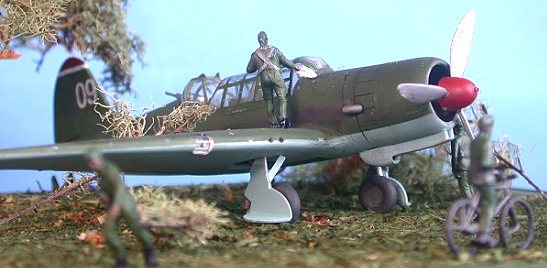 Moving onto the turret was
the part that I had been dreading but after all that worrying it turned into a
relatively easy task, the most important thing is to spend a bit of time
studying the instructions as there are 5 pieces to the turret assembly and they
do go together in a certain order, this is defiantly one time you follow the
instructions!
Moving onto the turret was
the part that I had been dreading but after all that worrying it turned into a
relatively easy task, the most important thing is to spend a bit of time
studying the instructions as there are 5 pieces to the turret assembly and they
do go together in a certain order, this is defiantly one time you follow the
instructions!
As noted before I had decided to do a diorama of the painting depicted on the box top as I was very taken with the picture, now I'm not normally a diorama sort of modeller and some of the construction techniques are are little unusual so bare with me.
A base was dually cut out and covered with straw "dust" as it depicted the Russian long tundra grass better than the standard railway grass that I had on hand which to me looked like dyed sawdust ummm wait a minute it is dyed sawdust!. The tree came from a Tea-Tree growing in the front yard and the leaves are dried rose petals cut up into small pieces and glued onto the tree twigs then dried moss from the dead apple tree out the back was glued on the twigs to give the impression of "leaves", not perfect but at least as good as some of the fake railway trees I looked at in the local model shop and I was looking for that Autumn look of greens and browns anyway.
Small boxes were fastened from plastic card and the drums made out of wine bottle foil rolled around a knife handle and painted green and the bombs came with the kit .
Pilot Figure came from a Italeri He 111 Zwilling and Airfix RAF ground crew set suitably modified and painted to look like VVS personal, not perfect but passable if you've never seen VVS personal up close and personal.
|
PAINTING & MARKINGS |
Painting of Russian aircraft is generally the easiest of all air forces as most aircraft were various shades of green and blue, ICM color calls for Humbrol 105 green and Blue 65 so as I had them on hand they were used, a "primer" green was gunned over first around the wing roots and areas of heavy wear then Humbrol 105 green was patch sprayed to give the effects of heavy paint wear around the wing roots as seen on a number of Su-2 photos. Once the top coat was dry it then was masked off and the underside sprayed that wonderful shade of blue.
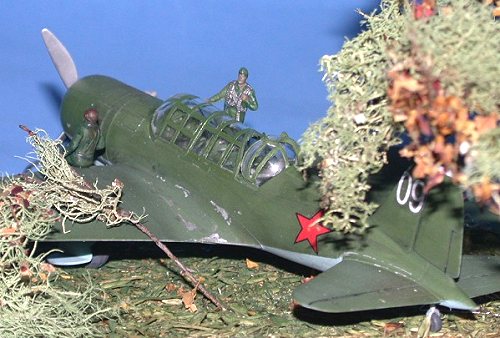 A couple of coats of future
were applied and then it was time for the decals, this time I decided to try the
ICM decals as I normally paint the Russian star directly onto the model. The
decals were very thin and matte but even applied over a gloss surface they
silvered slightly and were touched up with paint, the red tip on the tail was
airbrushed using Humbrol red and the white band came from a Hasegawa white decal
sheet.
A couple of coats of future
were applied and then it was time for the decals, this time I decided to try the
ICM decals as I normally paint the Russian star directly onto the model. The
decals were very thin and matte but even applied over a gloss surface they
silvered slightly and were touched up with paint, the red tip on the tail was
airbrushed using Humbrol red and the white band came from a Hasegawa white decal
sheet.
Once dry the "dirt and grime" was added using my usual method of using HP printer ink, a little water and a drop of washing up liquid, hey I'm a computer tech and hate wasting things :) normally I wipe the thinned ink over the entire aircraft and then using a clean dry cloth and wiping in the direction of the airflow carefully wipe most of the ink away, this method is far easier for me than oil washes as without fail I will screw up a oil wash. good thing about HP ink is that until it is sealed with a coat of varnish plain old water will remove it if you not happy with the end result or you need to thin down the grime.
Final effects was the addition of paint flaking and chipping that were evident in the photos kindly sent to me by Robert Lundin, the chipping was done using a silver pen available in most chain stores the end result didn't look too bad but I think that around the wing roots ended up being a little too scuffed for my liking.....ah well.
|
CONCLUSIONS |
Well there you have it, a neat model of a little known Russian light bomber that ICM should be applauded for releasing and by the looks of things the problems with the sink marks in the first batches have been sorted. If you can have a nose at the sprues before purchase, do so because this is one kit that will fill a big gap in your 1/72nd scale VVS collection.
|
REFERENCES |
Theres not a lot out there on the Su-2 but a trip to the VVS website is a must, not just for the Su-2 but any VVS aircraft from 1935-45.
Robert Lundin who sent me a stack of photos.
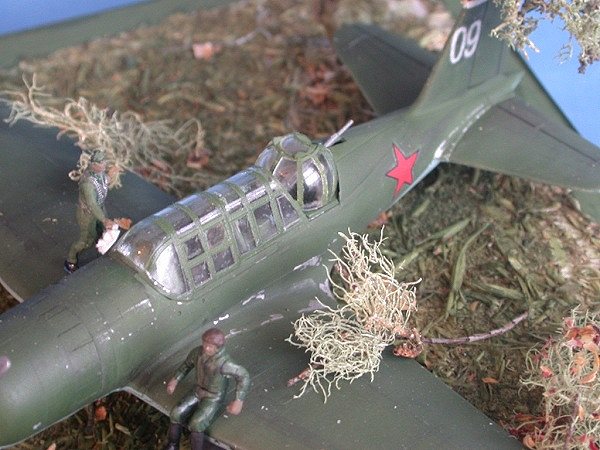
Copyright ModelingMadness.com. All rights reserved. No reproduction in any form without express permission from the editor.
If you would like your product reviewed fairly and fairly quickly, please contact the editor or see other details in the Note to Contributors.